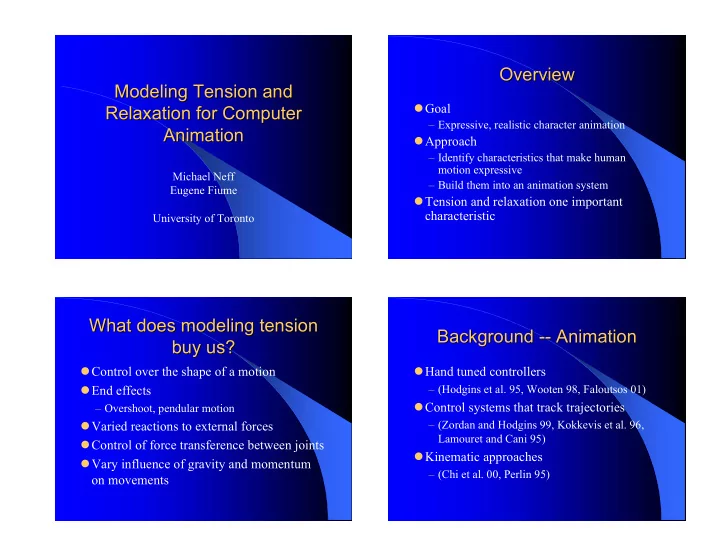

Overview Overview Modeling Tension and Modeling Tension and � Goal Relaxation for Computer Relaxation for Computer – Expressive, realistic character animation Animation Animation � Approach – Identify characteristics that make human motion expressive Michael Neff – Build them into an animation system Eugene Fiume � Tension and relaxation one important characteristic University of Toronto What does modeling tension What does modeling tension Background -- Animation Background -- Animation buy us? buy us? � Control over the shape of a motion � Hand tuned controllers – (Hodgins et al. 95, Wooten 98, Faloutsos 01) � End effects � Control systems that track trajectories – Overshoot, pendular motion � Varied reactions to external forces – (Zordan and Hodgins 99, Kokkevis et al. 96, Lamouret and Cani 95) � Control of force transference between joints � Kinematic approaches � Vary influence of gravity and momentum – (Chi et al. 00, Perlin 95) on movements
Background – – Biomechanics Biomechanics Equilibrium Point Control Background Equilibrium Point Control � Human body organizes muscles in agonist- � Joints are effected by two types of forces antagonist pairs – Active, or internal, forces – Regulate joint stiffness – External forces � Spring-like behaviour an important attribute of � Equilibrium point control balances these muscles forces to achieve the desired angle � Equilibrium point hypothesis – Avoids steady state error due to gravity – Humans may move limbs by varying the equilibrium point generated by the muscles around a limb � Many attributes of real muscle not included Antagonistic Formulation Antagonistic Formulation Antagonistic Formulation Antagonistic Formulation � 2 angular springs in � Set point of each spring is fixed and placed just opposition and a past limit of the joint damper at each joint � Position controlled by varying the two gains � Equation for antagonistic control: � = k L ( � L � � ) + k H ( � H � � ) � k d ˙ � � Stiffness is the sum of the two gains
Gain Space Figure of Gain Space Gain Space Figure of Gain Space Sample Isoangle Lines for a Limb 200 � Any angle is a line in gain space � Spring gains for a given angle are related as 150 follows: -10 10 Gain K H 30 100 50 70 90 � L � � eq � ExternalForce k H = k L 50 � eq � � H � H � � eq 0 0 50 100 150 200 Gain K L � Vary tension by moving along isoangle line. PD and Antagonistic Control Moving a Limb PD and Antagonistic Control Moving a Limb � Since linear springs are used, there is an � � Take the starting gains Moving a Limb equivalence between the two. 200 – (However, interpolating in the two spaces is not necessarily equivalent) 150 � We find antagonistic control to be a more Gain K H 100 10 natural parameterization. – Separates stiffness and position control 50 0 0 50 100 150 200 Gain K L
Moving a Limb Moving a Limb Moving a Limb Moving a Limb 2. Determine the isoangle line for the desired end 3. Draw a line of slope –1 between the start point point. and end line. Moving a Limb Moving a Limb 200 200 150 150 10 Gain K H 10 Gain K H 70 100 100 70 Slope -1 50 50 0 0 0 50 100 150 200 0 50 100 150 200 Gain K L Gain K L Moving a Limb Moving a Limb Moving a Limb Moving a Limb 4. Vary gains by moving along this line in order to � For high tension, the movement of the move the limb. limb will precisely track the trajectory of Moving a Limb the the movement along the line. 200 � Low tension more loosely tracks the 150 trajectory. 10 Gain K H 70 100 Slope -1 50 0 0 50 100 150 200 Gain K L
Shape Control Through Shape Control Through Effect of Tension on Tracking Effect of Tension on Tracking Tension Variation Tension Variation � Changing tension during a transition will change the shape of a trajectory � Increasing tension causes the limb to move more quickly at the beginning and slowly at the end � Decreasing tension causes the limb to move slowly at the beginning and quickly towards the end of the motion Shape Control Through Shape Control Through Shape Control Through Shape Control Through Tension Variation Tension Variation Tension Variation Tension Variation Sample Isoangle Lines for a Limb 200 -10 150 10 30 Gain K H 50 100 70 90 Slope -1 50 Reduce Tension 0 0 50 100 150 200 Gain K L
Shape Control Through Shape Control Through Results: Gestures Results: Gestures Tension Variation Tension Variation � High tension and relaxing nods � Giving the direction “Go left” Results: Kinematic vs. Tension Results: Gestures vs. Tension Results: Kinematic vs. Tension Results: Gestures vs. Tension Controlled Controlled Controlled Controlled � Giving the direction “Go left” - Kinematic � Giving the direction “Go left” – w/Tension Control
Results: Anticipation of External Results: Anticipation of External Results: Postures Results: Postures Forces Forces � Shrug � Shoves with varied tension Results: Anticipation of External Results: Anticipation of External Discussion Discussion Forces Forces � Shape control by varying tension seems to � Different shove reactions be easier than trying to adjust transition functions. – Takes character to correct physical state. � Achieves nicely nuanced movement � The techniques are low level, but are meant as a building block to create higher level systems.
Questions? Questions? www.dgp.toronto.edu/~neff
Recommend
More recommend